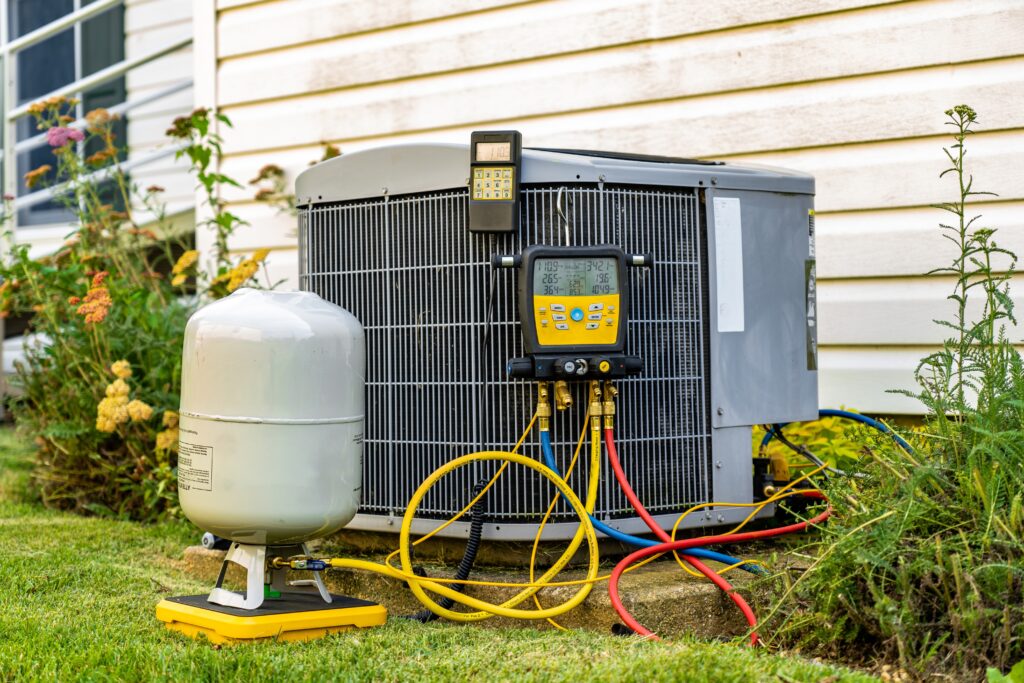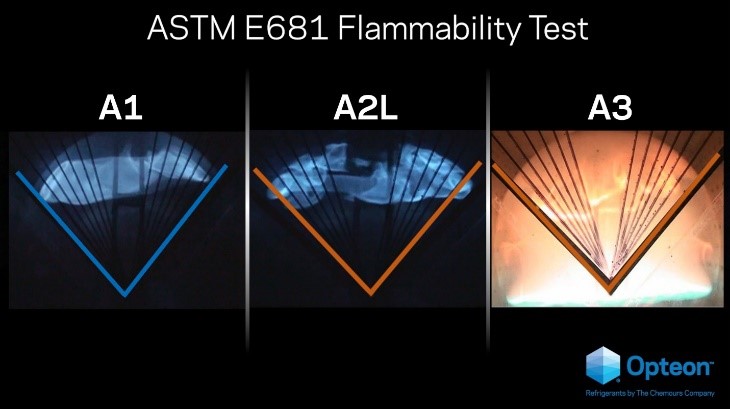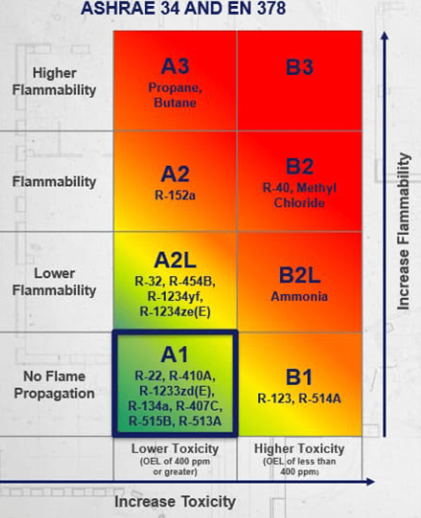
Although the new EPA refrigerant phase-out arrived January 1st of this year, we are just now receiving questions, concerns and preferences from homeowners and designers. Based on the number of inquiries pouring in, we thought it would be helpful to clarify what the phase-out means, share which new refrigerants are being used, and, most importantly, address some misinformation about flammability of these newer refrigerants.
Refrigerants and Global Warming Potential
Refrigerant, used in all heat pump systems, has a Global Warming Potential (GWP). GWP is the impact on global warming relative to carbon dioxide (CO2 has a GWP of 1). Heat pump refrigerant is a closed loop system, meaning the refrigerant shouldn’t find its way into the atmosphere. However, in reality, refrigerant leaks are incredibly common and improper disposal when replacing systems happens frequently in the industry, so reducing the GWP in refrigerants is extremely important.
This is not the first phase out for refrigerant. R-22 was invented in 1928 and became the standard used in residential air conditioners for decades. It was later found that the chlorine component was damaging to the ozone layer, and R-22 was included in the 1987 Montreal Protocol’s list of substances to be phased out of production over time. In 2010, R-22 was banned from production and importation, leading to the implementation of an alternative refrigerant, R-410A.
R-410A, our most common standard refrigerant, is a mixture of 50% R-32 and 50% R-125 and has a GWP of 2,088(note that the number following “R” is based on molecular structure and is unrelated to either GWP or sequencing in development). R-410A is sold under the names Puron, AZ-20, EcoFluor, Forane, Genetron, and Suva depending on where you live. The latest phase-out was triggered by the AIM Acts of 2020. The mandated reduction began in 2022 with a 10% reduction in HFCs, followed by a 30% reduction in 2024, which is the current driver of change in refrigerants today. As of January 1, 2025, the GWP cap is 700.
In addition to the GWP of a refrigerant, manufacturers and specifiers also consider three additional properties:
Performance: Performance encompasses both capacity and efficiency, reflecting how effectively a refrigerant delivers temperatures and how much electricity must be used to deliver that capacity. While some refrigerants may have a very low GWP, it may be less efficient in delivering cooling, requiring significantly more volume of refrigerant.
Cost: Cost considerations include both developing the actual refrigerant as well as the potential for increased cost of equipment to use that particular refrigerant. Cost considerations also include maintenance, disposal and retrofit.
Flammability: A refrigerant’s flammability rating is an important consideration for the life and safety of people and property. The industry uses ASHRAE Standard 34, assessing both toxicity and flammability. “A” classifications have a low toxicity. For A refrigerants, ASHRAE classifies the refrigerants as A1 (no flame propagation) up to A3 (high flammability). Each refrigerant is tested with a ‘V’ propagation line to determine which classification they fall under.

It’s important to note that the difference between an A1 and A2L is much less significant than sometimes rumored ‘on the streets’. An A2L refrigerant is more flammable than A1, but as can be seen in the visualization
of the ‘V’ propagation cone, A2L is nowhere near an A3 product. An A3 refrigerant warrants focused mitigation for flammability, where both A1 and A2L refrigerants fit within typical standards of care in HVAC.
That being said, as manufactures work towards meeting the AIM Act, many are mitigating the slight increased flammability risk of using A2L refrigerants with lower GWPs by including additional sensors and mechanisms to safely disperse the refrigerant in case of a leak in their HVAC equipment.

Replacement Options
Currently, the two most common replacement refrigerants meeting AIM Act are R-32 and R-454B. Both are classified an A2L refrigerant, meaning they are mildly flammable but still considered safe for use with proper handling and safety precautions. As previously mentioned, R-32 was 50% of R-410A, is already used in many countries and has a GWP of 675.
R-454B has an even lower GWP of 466 and is a mixture of R-32 and R-1234yf. This refrigerant performs very similarly to R-410A, achieving the same performance for a lower GWP.
Natural Refrigerants
Natural refrigerants, also known as ultra-low GWP refrigerants, are being employed or considered by manufactures as well. Two refrigerants we have been seeing lately are R-290 and R-744.
R-290, commonly known as propane, is a byproduct created during refinement of natural gas and petroleum and with a GWP of 3, this product is being considered as one of the available refrigerant replacements. However, R-290 is classified as A3, the highest flammability classification, causing concern due to the potential consequences of leaks.
R-744, commonly known as CO2, has gained traction with the growing availability of CO2-based equipment. It’s greatest benefit is it’s GWP of 1, and its affordability is also a significant driver. The main hesitation to adoption is that the units require higher operating pressure than other refrigerants. This means that retrofits aren’t very feasible, and the new equipment must be designed for those higher pressures, driving the cost of systems up.
Conclusion
As supply houses empty their shelves of older R410A equipment, we’ll be seeing more of these “newer” refrigerants come online. Understanding both GWP as well as flammability ratings will help with matching the best product for the specific application.
Refrigerant | GWP | Flammability |
R-410A | 2088 | A1 |
R-32 | 675 | A2L |
R-454B | 466 | A2L |
R-290 (Propane) | 3 | A3 |
R-744 (CO2) | 1 | A1 |
For more information and in-person trainings, please check out our events calendar at 3c-ren.org/calendar-of-events-and-trainings
The on-demand webinar page is at 3c-ren.org/on-demand-trainings
And feel free to reach out to the Code Coach Hotline for more information or to have your Energy Code or CALGreen questions answered! 3c-ren.org/energy-code-coach
